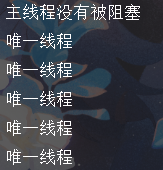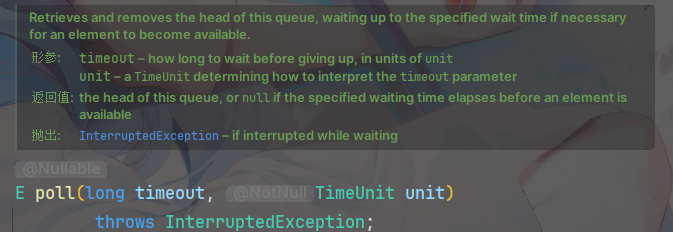手写线程池
涉及八股:exception,LockSupport,阻塞队列,线程池
仓库链接:SCMRCORE/mini-thread-pool: 手写一个mini的线程池
基础实现
public class MyThreadPool {
//1.线程什么时候创建?
//2.线程的Runnbale是什么?是我们提交的Command吗?
void execute(Runnable command){
new Thread(command).start();
}
}这样写当然能实现,但是我们线程池就是为了避免频繁创建和销毁线程带来的性能开销;
并且无法进行线程的手动管理,即使我们把任务装进List,线程在执行完任务后仍会自动销毁;
实现复用和管理(阻塞队列)
public class MyThreadPool {
List<Runnable> commandList = new ArrayList<>();
Thread thread = new Thread(()->{
while(true) {
if(!commandList.isEmpty()){
Runnable command = commandList.remove(0);
command.run();
}
}
});
void execute(Runnable command) {
commandList.add(command);
}
}和上一期的定时任务类似:
我们的execute将任务扔进容器,然后我们new Thread里面通过while循环,不断检查容器是否为空
Q:如果容器为空,一直while非常消耗CPU资源,有办法让容器为空时一直阻塞吗?
我们可以选择阻塞队列,同上一期类似,定时任务容器对顺序有要求,而这里只需要基础的阻塞队列即可:
public class MyThreadPool {
//阻塞队列,避免其他容器等待时疯狂消耗CPU资源
BlockingQueue<Runnable> blockingQueue = new ArrayBlockingQueue<>(1024);//需要指定容量
Thread thread = new Thread(()->{
while(true) {
try {
Runnable command = blockingQueue.take();
command.run();
} catch (InterruptedException e) {
throw new RuntimeException(e);
}
}
}, "唯一线程");
{//启动线程,创建类时会执行
thread.start();
}
void execute(Runnable command) {
//offer区别于add会有个返回值,我们会用到这个值来判断
boolean offfer = blockingQueue.offer(command);
}
}拓展:
InterruptedException在这里的逻辑是运行时被中断,则需要手动进行异常的catch处理。我们的sleep也有这个异常,JUC包里几乎所有需要等待的方法都有这个异常,除了locksupport的park方法
到这里我们就完成了一个线程的线程池了,由于我们的阻塞队列逻辑,不会自动停止需要我们手动停止:

实现池中的多个线程(corePoolSize)
只有一个线程显然不能满足我们的需求
public class MyThreadPool {
//阻塞队列,避免其他容器等待时疯狂消耗CPU资源
BlockingQueue<Runnable> blockingQueue = new ArrayBlockingQueue<>(1024);//需要指定容量
//将线程里的运行逻辑提取成一个共用task
private final Runnable task = ()->{
while(true) {
try {
Runnable command = blockingQueue.take();
command.run();
} catch (InterruptedException e) {
throw new RuntimeException(e);
}
}
};
private int corePoolSize = 10;
//用容器存储线程,我们应该有多少个线程?
List<Thread> threadList = new ArrayList<>();
void execute(Runnable command) {
//offer区别于add会有个返回值,我们会用到这个值来判断
boolean offfer = blockingQueue.offer(command);
}
}因此,我们将线程复用的逻辑提取成一个Runnable,并用容器存储线程 ,用corePoolSize表示数量
完善execute逻辑(maxSize)
当我们的offer返回false,便是说明我们的线程已经用完了
private int corePoolSize = 10;
private int maxSize = 16;
//用容器存储线程
List<Thread> coreList = new ArrayList<>();
//核心线程已满,需要辅助线程来帮我们处理任务
List<Thread> supportList = new ArrayList<>();//maxSize-corePoolSize
void execute(Runnable command) {
//判断ThreadList有多少元素,没到corePoolSize就创建线程
if(coreList.size()<corePoolSize){
Thread thread = new Thread(task);
coreList.add(thread);
thread.start();
}
//offer区别于add会有个返回值,我们会用到这个值来判断
if(!blockingQueue.offer(command)){
Thread thread =new Thread(task);
supportList.add(thread);
thread.start();
}
}这里便引入了maxSize,核心线程已满,需要辅助线程来帮我们处理任务,用supportList来存
Q:如果辅助线程也满了怎么办呢?同时我们这里操作不是原子的,涉及线程安全问题
PS:演示demo就不解决线程安全问题了(CAS和锁),但是我们要知道
再完善下execute
private int corePoolSize = 10;
private int maxSize = 16;
//用容器存储线程
List<Thread> coreList = new ArrayList<>();
//核心线程已满,需要辅助线程来帮我们处理任务
List<Thread> supportList = new ArrayList<>();//maxSize-corePoolSize
void execute(Runnable command) {
//判断ThreadList有多少元素,没到corePoolSize就创建线程
if(coreList.size()<corePoolSize){
Thread thread = new Thread(task);
coreList.add(thread);
thread.start();
}
//offer区别于add会有个返回值,我们会用到这个值来判断
if(blockingQueue.offer(command)) return;
if(coreList.size() + supportList.size() < maxSize){
Thread thread =new Thread(task);
supportList.add(thread);
thread.start();
}
//在多线程环境下,因为不是原子即使刚创建,也可能满
if(!blockingQueue.offer(command)){
throw new RuntimeException("阻塞队列满了!")
}
}优化:辅助线程空闲释放
一个线程如何让自己在空闲的时候结束呢?
我们设置一个超时时间,超过了超时时间仍然没拿到任务,说明此时的线程池不忙碌,辅助线程就应该自己结束。
这里我们看一下BlockingQueue的API,poll函数有两个参数,超时时间和单位,也就是超过时间仍然没拿到则返回null

因此,修改我们的task逻辑,将核心线程和辅助线程分开,execute里记得改下参数名,这里就不演示了
//将线程里的运行逻辑提取成一个共用task
private final Runnable coreTask = ()->{
while(true) {
try {
Runnable command = blockingQueue.take();
command.run();
} catch (InterruptedException e) {
throw new RuntimeException(e);
}
}
};
//核心线程任务和辅助线程任务要做一个区分
private final Runnable supportTask = ()->{
while(true) {
try {
Runnable command = blockingQueue.poll(1, TimeUnit.SECONDS);
if(command==null) {
break;//如果没null说明空闲,break后会自动推出循环,线程结束
}
command.run();
} catch (InterruptedException e) {
throw new RuntimeException(e);
}
}
System.out.println(Thread.currentThread().getName()+"线程结束了!");
};优化:超时时间如何设置(timeout和timeUnit)
我们也得知道具体设置多少超时时间,于是将两个参数timeout和timeUnit单独列出来,放入构造函数
private int corePoolSize;
private int maxSize;
private int timeout;
private TimeUnit timeUnit;
public MyThreadPool(int corePoolSize, int maxSize, int timeout, TimeUnit timeUnit){
this.corePoolSize = corePoolSize;
this.maxSize = maxSize;
this.timeout = timeout;
this.timeUnit = timeUnit;
}同时,我们可以把两个task封装成两个类
//将线程里的运行逻辑提取成一个共用task,并且可以将两个task封装为类方便调用
class CoreThread extends Thread{
@Override
public void run() {
while(true) {
try {
Runnable command = blockingQueue.take();
command.run();
} catch (InterruptedException e) {
throw new RuntimeException(e);
}
}
}
}
class SupportThread extends Thread{
@Override
public void run() {
while(true) {
try {
Runnable command = blockingQueue.poll(timeout, timeUnit);
if(command==null) {
break;//如果没null说明空闲,break后会自动推出循环,线程结束
}
command.run();
} catch (InterruptedException e) {
throw new RuntimeException(e);
}
}
System.out.println(Thread.currentThread().getName()+"线程结束了!");
}
}同时,我们也可以把阻塞队列放入构造函数,让用户自己定义
private int corePoolSize;
private int maxSize;
private int timeout;
private TimeUnit timeUnit;
//阻塞队列,避免其他容器等待时疯狂消耗CPU资源
BlockingQueue<Runnable> blockingQueue;//用户传入时需要指定容量
public MyThreadPool(int corePoolSize, int maxSize, int timeout, TimeUnit timeUnit, BlockingQueue<Runnable> blockingQueue){
this.corePoolSize = corePoolSize;
this.maxSize = maxSize;
this.timeout = timeout;
this.timeUnit = timeUnit;
this.blockingQueue = blockingQueue;//需要指定容量
}测试用例:
@SpringBootApplication
public class ThreadPoolApplication {
public static void main(String[] args) {
MyThreadPool myThreadPool = new MyThreadPool(2, 4, 1, TimeUnit.SECONDS, new ArrayBlockingQueue<>(2));
for (int i = 0; i < 5; i++) {
myThreadPool.execute(()->{
try {
Thread.sleep(1000);
} catch (InterruptedException e) {
throw new RuntimeException(e);
}
System.out.println(Thread.currentThread().getName());
});
}
System.out.println("主线程没有被阻塞");
}
}
//TODO 无法复现视频里的拒绝策略(Handler)
阻塞队列满了,则会抛异常,这样的话,我们可以把抛异常单独拿出来,组合成一个拒绝策略。
生成一个reject接口,具体的异常,只需要实现这个接口即可
public interface RejectHandle {
//拒绝策略的话,我们肯定要任务信息和线程池的信息,所以传入这俩
void reject(Runnable rejectCommand, MyThreadPool myThreadPool);
}同样是装入构造函数
private int corePoolSize;
private int maxSize;
private int timeout;
private TimeUnit timeUnit;
//阻塞队列,避免其他容器等待时疯狂消耗CPU资源
BlockingQueue<Runnable> blockingQueue;//用户传入时需要指定容量
private final RejectHandle rejectHandle;
public MyThreadPool(int corePoolSize, int maxSize, int timeout, TimeUnit timeUnit, BlockingQueue<Runnable> blockingQueue, RejectHandle rejectHandle) {
this.corePoolSize = corePoolSize;
this.maxSize = maxSize;
this.timeout = timeout;
this.timeUnit = timeUnit;
this.blockingQueue = blockingQueue;//需要指定容量
this.rejectHandle=rejectHandle;
}并且在execute里把throw替换成reject
void execute(Runnable command) {
//判断ThreadList有多少元素,没到corePoolSize就创建线程
if(coreList.size()<corePoolSize){
Thread thread = new CoreThread();
coreList.add(thread);
thread.start();
}
//offer区别于add会有个返回值,我们会用到这个值来判断
if(blockingQueue.offer(command)) return;
if(coreList.size() + supportList.size() < maxSize){
Thread thread =new SupportThread();
supportList.add(thread);
thread.start();
}
//在多线程环境下,因为不是原子即使刚创建,也可能满
if(!blockingQueue.offer(command)){
rejectHandle.reject(command, this);
}
}实现自定义拒绝策略
public class ThrowRejectHandler implements RejectHandle{
@Override
public void reject(Runnable rejectCommand, MyThreadPool myThreadPool) {
throw new RuntimeException("阻塞队列已满");
}
}测试:
@SpringBootApplication
public class ThreadPoolApplication {
public static void main(String[] args) {
MyThreadPool myThreadPool = new MyThreadPool(2, 4, 1, TimeUnit.SECONDS, new ArrayBlockingQueue<>(2), new ThrowRejectHandler());
for (int i = 0; i < 5; i++) {
myThreadPool.execute(()->{
try {
Thread.sleep(1000);
} catch (InterruptedException e) {
throw new RuntimeException(e);
}
System.out.println(Thread.currentThread().getName());
});
}
System.out.println("主线程没有被阻塞");
}
}完整代码
MyThreadPool
public class MyThreadPool {
private int corePoolSize;
private int maxSize;
private int timeout;
private TimeUnit timeUnit;
//阻塞队列,避免其他容器等待时疯狂消耗CPU资源
BlockingQueue<Runnable> blockingQueue;//用户传入时需要指定容量
private final RejectHandle rejectHandle;
public MyThreadPool(int corePoolSize, int maxSize, int timeout, TimeUnit timeUnit, BlockingQueue<Runnable> blockingQueue, RejectHandle rejectHandle) {
this.corePoolSize = corePoolSize;
this.maxSize = maxSize;
this.timeout = timeout;
this.timeUnit = timeUnit;
this.blockingQueue = blockingQueue;//需要指定容量
this.rejectHandle=rejectHandle;
}
//省略get方法
//用容器存储线程
List<Thread> coreList = new ArrayList<>();
//核心线程已满,需要辅助线程来帮我们处理任务
List<Thread> supportList = new ArrayList<>();//maxSize-corePoolSize
void execute(Runnable command) {
//判断ThreadList有多少元素,没到corePoolSize就创建线程
if(coreList.size()<corePoolSize){
Thread thread = new CoreThread();
coreList.add(thread);
thread.start();
}
//offer区别于add会有个返回值,我们会用到这个值来判断
if(blockingQueue.offer(command)) return;
if(coreList.size() + supportList.size() < maxSize){
Thread thread =new SupportThread();
supportList.add(thread);
thread.start();
}
//在多线程环境下,因为不是原子即使刚创建,也可能满
if(!blockingQueue.offer(command)){
rejectHandle.reject(command, this);
}
}
//将线程里的运行逻辑提取成一个共用task,并且可以将两个task封装为类方便调用
class CoreThread extends Thread{
@Override
public void run() {
while(true) {
try {
Runnable command = blockingQueue.take();
command.run();
} catch (InterruptedException e) {
throw new RuntimeException(e);
}
}
}
}
class SupportThread extends Thread{
@Override
public void run() {
while(true) {
try {
Runnable command = blockingQueue.poll(timeout, timeUnit);
if(command==null) {
break;//如果没null说明空闲,break后会自动推出循环,线程结束
}
command.run();
} catch (InterruptedException e) {
throw new RuntimeException(e);
}
}
System.out.println(Thread.currentThread().getName()+"线程结束了!");
}
}
}RejectHandler
public interface RejectHandle {
//拒绝策略的话,我们肯定要任务信息和线程池的信息,所以传入这俩
void reject(Runnable rejectCommand, MyThreadPool myThreadPool);
}ThrowRejectHandler
public class ThrowRejectHandler implements RejectHandle{
@Override
public void reject(Runnable rejectCommand, MyThreadPool myThreadPool) {
throw new RuntimeException("阻塞队列已满");
}
}test
@SpringBootApplication
public class ThreadPoolApplication {
public static void main(String[] args) {
MyThreadPool myThreadPool = new MyThreadPool(2, 4, 1, TimeUnit.SECONDS, new ArrayBlockingQueue<>(2), new ThrowRejectHandler());
for (int i = 0; i < 4; i++) {
myThreadPool.execute(()->{
try {
Thread.sleep(1000);
} catch (InterruptedException e) {
throw new RuntimeException(e);
}
System.out.println(Thread.currentThread().getName());
});
}
System.out.println("主线程没有被阻塞");
}
}思考
- 演示demo就没有保证execute的原子性,存在线程安全问题
- 线程池缺少shutdown功能,能增加吗?
- 问:怎么理解拒绝策略?该如何回答?
- JDK线程池还有个ThreadFactory参数,干什么用的?